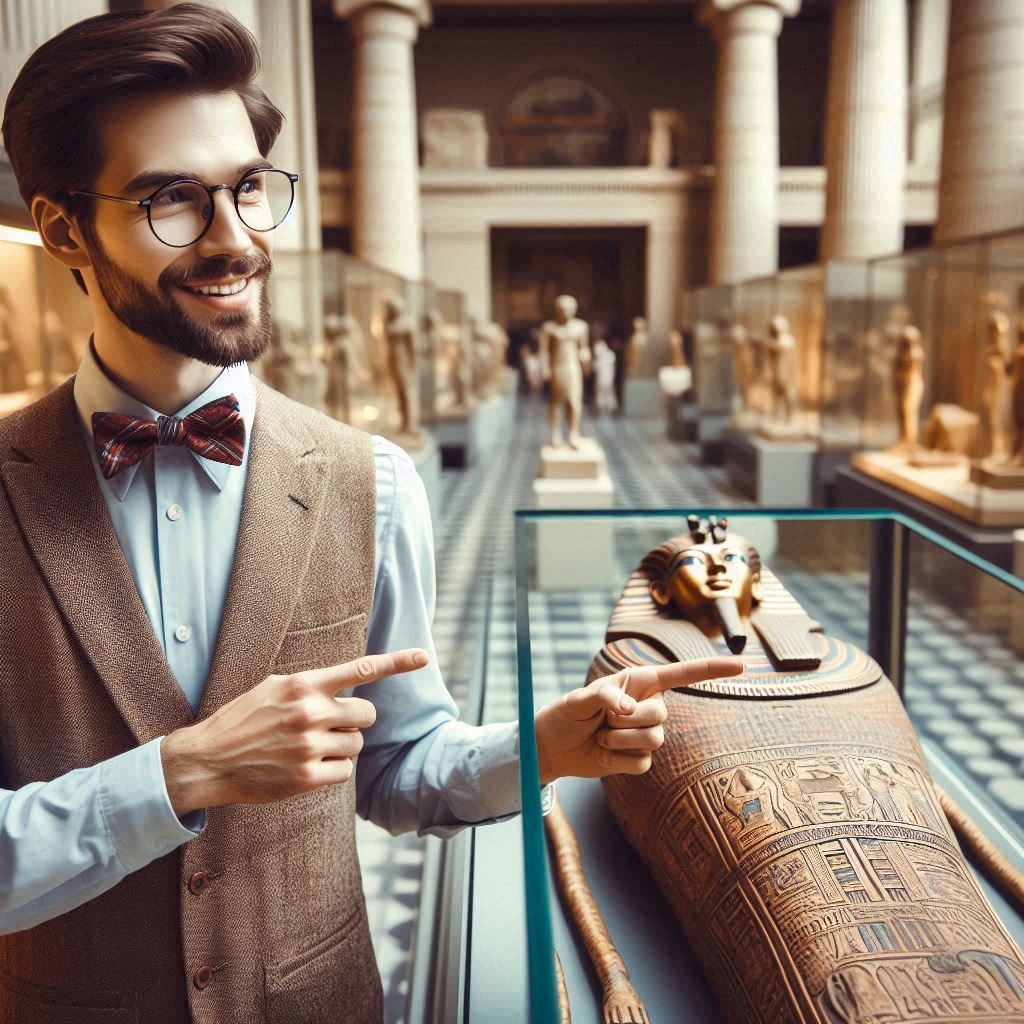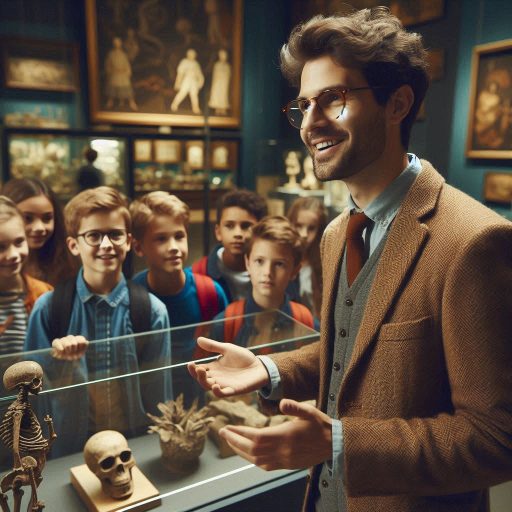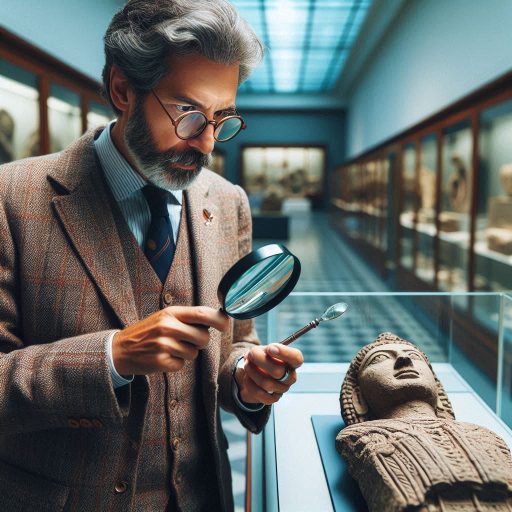Introduction
Curatorial practices play a vital role in creating engaging exhibits.
Effective curation transforms ordinary displays into immersive experiences that captivate visitors.
These practices enhance the overall visitor experience and promote deeper learning about the subject matter.
When curators thoughtfully select artifacts and arrange them strategically, they tell compelling stories.
Engaging exhibits encourage exploration, provoke curiosity, and invite visitors to connect with the content.
Additionally, well-designed displays foster an environment that supports educational initiatives, allowing audiences to gain new insights.
In this blog post, we will explore top curatorial practices that enhance exhibit engagement.
We will discuss the importance of thematic storytelling and how it captures visitor interest.
Next, we will examine the role of interactive elements that invite participation and foster hands-on learning.
Additionally, we will highlight the significance of audience feedback in shaping future exhibits.
Finally, we will provide practical tips for curators to implement these best practices effectively.
By employing these curatorial strategies, museums can create dynamic exhibits that resonate with audiences and promote meaningful learning experiences.
Understanding the Audience
Researching and Analyzing the Demographics of Visitors
Understanding your audience is fundamental to creating engaging exhibits.
Researching and analyzing visitor demographics helps curators tailor exhibits effectively.
By identifying who visits your museum, you can craft experiences that resonate with their interests.
Start by gathering data on visitor age, education level, and cultural background.
Use surveys, interviews, and observation to collect valuable insights.
Analyze this data to identify trends and preferences among different demographic groups.
This understanding allows you to shape your exhibit’s content and design to meet audience expectations.
Tailoring the Exhibit to Appeal to the Target Audience
Next, tailor the exhibit to appeal to your target audience.
Consider the interests and values of different demographic segments.
For example, if you notice a high number of families visiting, focus on family-friendly themes and activities.
Incorporate relevant storytelling elements that reflect their experiences and interests.
Moreover, ensure the exhibit communicates effectively with your audience.
Use accessible language and visuals that resonate with different educational backgrounds.
Curators can create informative panels and engaging graphics to enhance comprehension and appreciation.
Incorporating Interactive Elements to Engage Different Age Groups and Interests
Incorporating interactive elements is another effective way to engage various age groups and interests.
Interactive displays can captivate both children and adults.
Hands-on activities encourage participation and foster a sense of exploration.
Consider using technology like touchscreens, augmented reality, or virtual reality to create immersive experiences.
These tools can bring exhibits to life, making them more engaging for visitors.
Moreover, provide opportunities for audience participation.
This can include workshops, guided tours, or interactive demonstrations.
Engaging activities encourage visitors to connect with the content actively.
When people participate, they are more likely to remember and value their experience.
Understanding your audience also involves recognizing the diverse interests within visitor demographics.
Different groups may have varying levels of familiarity with your exhibit’s theme.
Therefore, it’s essential to cater to both novices and experts.
Create content that provides multiple layers of engagement, from basic information to in-depth exploration.
Utilize feedback to refine your approach continually.
Encourage visitors to share their thoughts and experiences through surveys or comment cards.
This information can help you assess whether your exhibit meets the audience’s needs and expectations.
Finally, staying updated on trends in audience engagement can enhance your efforts.
Research successful exhibits at other institutions to gather inspiration.
Learn from the best practices of your peers and adapt those ideas to your context.
Understanding your audience is critical for creating engaging exhibits.
By researching demographics, tailoring content, and incorporating interactive elements, you can craft memorable experiences.
These strategies will not only enhance visitor engagement but also promote learning and appreciation for your exhibits.
Read: Character Design Trends: What’s Hot in 2024?
Theme Development
Selecting a Cohesive and Engaging Theme for the Exhibit
Theme development is crucial for creating a captivating exhibit.
A well-selected theme serves as the foundation for all exhibit elements.
Start by choosing a cohesive and engaging theme that resonates with your target audience.
Consider the interests, cultural relevance, and current trends that will appeal to visitors.
A strong theme can evoke emotions, stimulate curiosity, and encourage exploration.
Research similar exhibits to identify successful themes and elements that worked well.
This can help inspire your own ideas.
Aim for a theme that is broad enough to allow for diverse interpretations while still maintaining focus.
This balance can create an engaging experience for various audience segments.
Creating a Narrative or Storyline to Guide Visitors Through the Exhibit
Once you have a theme, develop a narrative or storyline to guide visitors through the exhibit.
A compelling narrative creates a sense of journey, helping visitors connect emotionally with the content.
Start by outlining key points and artifacts that align with the theme.
Consider using a chronological approach, thematic sections, or personal stories to structure the narrative.
Each exhibit element should contribute to the overall story, providing context and depth.
Incorporate multimedia elements, such as videos and audio recordings, to enhance storytelling and engage visitors on multiple levels.
Ensuring the Theme is Relevant and Thought-Provoking for Visitors
It is essential to ensure that the theme is relevant and thought-provoking for visitors.
Address contemporary issues or cultural trends that resonate with your audience.
This relevance can create a deeper connection and stimulate meaningful discussions.
Involve community stakeholders, artists, or experts in the planning process.
Their insights can help shape the theme and ensure it addresses relevant topics.
Consider incorporating visitor feedback during the planning stages to gauge interest in potential themes.
Additionally, think about how the theme can challenge assumptions and provoke critical thinking.
Encouraging visitors to question and reflect on the subject matter can enhance their overall experience.
Thought-provoking themes can stimulate dialogue and inspire action beyond the museum walls.
Theme development is a vital component of creating engaging exhibits.
Selecting a cohesive and engaging theme, crafting a compelling narrative, and ensuring relevance are essential steps.
By focusing on these elements, curators can create memorable experiences that resonate with visitors and foster a deeper appreciation for the subject matter.
Engaging themes not only enhance visitor experiences but also promote learning and inspire curiosity.
Read: How to Price Your Ceramic Artwork
Display and Layout
Designing an Intuitive Layout That Flows Well and Is Easy to Navigate
The display and layout of an exhibit significantly impact visitor engagement.
Designing an intuitive layout is essential for creating a seamless experience.
Start by considering the natural flow of foot traffic.
Organize the space to guide visitors effortlessly from one section to another.
Use pathways and clear signage to help visitors navigate the exhibit easily.
Incorporate open spaces to avoid overcrowding and allow visitors to absorb information.
Create distinct zones for different themes or topics, ensuring each area is clearly defined.
This approach will help visitors focus on each section without feeling overwhelmed.
Placing Artifacts and Exhibits Strategically to Enhance Storytelling
Placing artifacts and exhibits strategically enhances storytelling and engagement.
Position key artifacts at focal points to draw attention and highlight their significance.
Consider the narrative structure when arranging exhibits.
Each artifact should contribute to the overall story, offering context and enhancing understanding.
Use visual hierarchies to guide visitors through the exhibit.
For example, larger artifacts can anchor sections, while smaller items can provide supporting details.
Group related items together to create connections and reinforce the theme.
This strategic placement encourages visitors to explore the exhibit while deepening their understanding of the subject matter.
Utilizing Lighting, Colors, and Other Visual Elements to Create a Visually Appealing Experience
Utilizing lighting, colors, and other visual elements is vital for creating an appealing experience.
Proper lighting can enhance the visibility of artifacts and set the mood of the exhibit.
Use a combination of ambient, task, and accent lighting to highlight key pieces and create an inviting atmosphere.
Color choices also play a significant role in exhibit design.
Select colors that align with the theme and evoke the desired emotions.
For instance, warm tones can create a welcoming environment, while cooler hues may impart a more serious tone.
Incorporate visual elements such as graphics, banners, or multimedia displays to enrich the experience.
Infographics and labels should be clear, concise, and visually engaging.
They can provide context and stimulate curiosity without overwhelming visitors with information.
Effective display and layout are crucial for engaging exhibits.
Designing an intuitive layout, strategically placing artifacts, and utilizing lighting and colors enhance the visitor experience.
By focusing on these elements, curators can create a visually appealing and memorable journey for their audiences.
Thoughtful display and layout not only improve navigation but also reinforce the storytelling aspects of the exhibit.
Ultimately, this leads to a richer understanding and appreciation of the subject matter.
Read: Top Skills Needed for a Successful Character Designer

Interpretation and Information
Providing Clear and Concise Labels for Artifacts and Exhibits
Effective interpretation and information are essential for enhancing the visitor experience.
Start by providing clear and concise labels for artifacts and exhibits.
Labels should communicate key information quickly and effectively.
Aim for brevity while ensuring visitors understand the significance of each item.
Use simple language and avoid jargon to ensure accessibility for all visitors.
Include essential details such as the title, date, creator, and context of the artifact.
This foundational information helps visitors connect with the exhibit.
Position labels at eye level to ensure visibility and make them easy to read.
Consistent formatting across labels will also help visitors navigate the exhibit smoothly.
Offering Additional Information and Resources for Visitors Who Want to Delve Deeper
Offering additional information and resources can enrich the visitor experience for those who want to delve deeper.
Consider providing supplementary materials, such as pamphlets or brochures, that expand on the exhibit’s themes.
These resources can offer insights into related topics or highlight further reading materials.
Another approach is to create digital content, such as downloadable guides or website links, that visitors can access on their devices.
This allows visitors to explore topics of interest at their own pace.
Highlighting related exhibits or events can also encourage ongoing engagement with your museum.
Incorporating Multimedia Elements Such as Videos or Audio Guides for Interactive Learning
Incorporating multimedia elements can significantly enhance interpretation and foster interactive learning.
Videos and audio guides provide dynamic ways to present information and engage visitors.
Use short video clips to illustrate key concepts or showcase behind-the-scenes processes related to the exhibit.
Audio guides offer visitors the flexibility to learn at their own pace.
Curators can create guided tours that provide in-depth commentary on exhibits and artifacts.
These tools can also accommodate different learning styles, making the exhibit accessible to a broader audience.
Interactive touchscreens can serve as additional resources.
They allow visitors to explore topics more deeply through images, videos, and links to related content.
Such technology can transform passive observation into an engaging learning experience.
Effective interpretation and information are vital for engaging exhibits.
Providing clear and concise labels, offering additional resources, and incorporating multimedia elements all contribute to a richer visitor experience.
By focusing on these aspects, curators can ensure that visitors not only enjoy the exhibits but also leave with a deeper understanding of the subject matter.
Engaging interpretation fosters curiosity, inspires learning, and encourages a lasting connection to the museum and its collections.
Read: Career Paths in Ceramic Art and Design
Engagement Activities
Including Hands-On Activities or Interactive Displays to Encourage Participation
Engagement activities are essential for fostering a dynamic visitor experience.
Including hands-on activities or interactive displays encourages participation and invites exploration.
These elements can transform passive viewing into active learning, allowing visitors to connect more deeply with the exhibit.
Consider incorporating tactile elements that visitors can touch or manipulate.
For example, interactive stations where guests can assemble parts of an artifact or engage with replicas can enhance their understanding.
Digital displays that allow visitors to explore different aspects of an exhibit can also create engaging experiences.
By actively involving visitors, these activities can enhance retention and create lasting memories.
Interactive displays encourage curiosity, allowing visitors to ask questions and discover answers through exploration.
Hosting Workshops, Lectures, or Guided Tours to Enhance the Visitor Experience
Hosting workshops, lectures, or guided tours can significantly enhance the visitor experience.
These activities provide opportunities for deeper engagement with the exhibit’s themes.
Workshops can allow visitors to explore specific topics in detail, promoting hands-on learning.
Inviting guest speakers or experts for lectures can provide unique insights into the exhibit’s subject matter.
This adds depth and encourages visitors to think critically about what they see.
Guided tours led by knowledgeable staff can also offer context and answer questions, enriching the overall experience.
Consider tailoring these activities to different audience segments, such as families, students, or adult learners.
This targeted approach ensures that everyone can find something of interest.
Creating Opportunities for Visitors to Share Their Thoughts and Feedback on the Exhibit
Creating opportunities for visitors to share their thoughts and feedback enhances engagement.
Implementing comment boards or digital kiosks allows visitors to express their opinions on the exhibit.
This encourages dialogue and makes visitors feel valued in the museum experience.
Surveys can also be a useful tool for gathering insights on visitor experiences.
These can help curators understand what aspects of the exhibit resonated most and where improvements can be made.
Consider offering incentives, like a small prize or discount on admission, to encourage participation in feedback activities.
Additionally, hosting community discussions or focus groups can provide a platform for deeper engagement.
Inviting diverse perspectives allows curators to understand the community’s interests and needs better.
Engagement activities play a crucial role in creating a memorable visitor experience.
By including hands-on activities, hosting informative events, and encouraging feedback, museums can foster meaningful connections with their audiences.
Engaging visitors not only enhances their understanding of the exhibit but also creates a sense of belonging within the museum community.
Ultimately, these activities can inspire visitors to return and share their experiences with others.
Transform Your Career Today
Unlock a personalized career strategy that drives real results. Get tailored advice and a roadmap designed just for you.
Start NowAccessibility and Inclusivity
Ensuring the Exhibit Is Accessible to All Visitors, Including Those with Disabilities
Accessibility and inclusivity are vital components of creating engaging exhibits.
Ensuring that the exhibit is accessible to all visitors, including those with disabilities, should be a top priority for curators.
Begin by assessing the physical space of the exhibit.
Ensure that pathways are wide enough for wheelchairs and mobility aids.
Install ramps and elevators where necessary, and make sure all areas are easily navigable.
Additionally, provide accessible seating options and spaces for resting.
Consider sensory-friendly areas for visitors who may be overwhelmed by noise or crowds.
Use clear signage and tactile maps to enhance navigation for visually impaired visitors.
Braille labels and audio descriptions can help ensure that all visitors have access to exhibit information.
By prioritizing accessibility, museums create a welcoming environment for everyone and demonstrate their commitment to inclusion.
Providing Multi-Language Support or Translations for Diverse Audiences
Providing multi-language support or translations significantly enhances inclusivity.
Many museums serve diverse communities, making it essential to offer materials in multiple languages.
Translate exhibit labels, brochures, and digital content to ensure visitors can fully engage with the information presented.
This approach allows non-native speakers to appreciate the exhibit’s themes and narratives.
Consider implementing audio guides or mobile apps that provide translations and audio descriptions.
These resources allow non-English speakers and those with visual impairments to access content easily.
Using a variety of media ensures that all visitors can engage with the exhibit on their terms.
By offering language support, museums demonstrate their commitment to inclusivity and respect for diverse audiences.
Creating a Welcoming and Inclusive Environment for Everyone
Creating a welcoming and inclusive environment involves more than just physical accessibility.
Foster a culture of inclusivity by training staff to be aware of diverse needs and perspectives.
This training can include workshops on disability awareness and cultural sensitivity.
Encourage staff to approach all visitors with respect and openness, ensuring everyone feels valued.
Hosting community events that celebrate diverse cultures and perspectives can further enhance inclusivity.
Engaging with local communities helps museums understand their audience better and develop programs that reflect their interests.
Collaborating with community organizations can lead to new insights and enhance cultural relevance.
Such partnerships can foster trust and create a sense of ownership among diverse visitor groups.
Accessibility and inclusivity are crucial for creating engaging exhibits.
Ensuring physical access, providing language support, and fostering a welcoming environment will deepen connections with all visitors.
By prioritizing these elements, museums can enhance the visitor experience and make their exhibits truly accessible and inviting.
A commitment to inclusivity not only enriches the museum environment but also reflects the diverse community it serves.
Ultimately, an inclusive approach encourages all visitors to explore, learn, and appreciate the exhibits on display.
Museums that embrace accessibility and inclusivity set a standard for excellence, creating memorable experiences for everyone.
Collaboration with Stakeholders
Working with Artists, Historians, and Other Experts to Curate the Exhibit
Collaboration with artists, historians, and other experts is essential for curating a successful exhibit.
Engaging with these professionals enriches the narrative and adds depth to the exhibit’s themes.
Artists can provide unique perspectives and creative input, while historians offer valuable context and insights.
By working together, curators can ensure that the exhibit is well-rounded and informative.
Host brainstorming sessions or workshops to foster collaboration and generate innovative ideas.
Encourage open dialogue and invite experts to contribute their knowledge and experiences.
This collaborative approach not only enhances the quality of the exhibit but also builds a sense of ownership among stakeholders.
Collaborating with Community Organizations or Local Businesses to Promote the Exhibit
Collaborating with community organizations and local businesses can significantly boost the visibility of an exhibit.
These partnerships can help engage a broader audience and create a sense of community involvement.
Local organizations can assist in outreach efforts, while businesses can provide resources or sponsorships to enhance the exhibit.
Consider hosting joint events that celebrate the exhibit and promote local culture.
For example, partner with a local restaurant to offer themed food nights that complement the exhibit’s focus.
This collaboration creates a richer experience for visitors and strengthens community ties.
Additionally, leveraging social media and local media outlets can amplify promotional efforts.
Shared messaging between the museum and partners can reach diverse audiences and generate excitement.
Seeking Feedback and Input from Visitors and Stakeholders to Improve Future Exhibits
Seeking feedback from visitors and stakeholders is crucial for continuous improvement.
Create opportunities for guests to share their experiences through surveys, comment cards, or digital platforms.
This feedback helps curators understand what resonates with visitors and what areas may need enhancement.
Engaging stakeholders, including community leaders and educational institutions, can provide valuable insights into community needs and interests.
Regularly hold focus groups or meetings to gather input on upcoming exhibits or programs.
By including diverse perspectives, museums can create more relevant and engaging experiences.
Consider implementing a feedback loop where visitors can see how their input influences future exhibits.
This approach fosters a sense of community and encourages repeat visits.
Collaboration with stakeholders plays a vital role in curating engaging exhibits.
Working with experts enhances the quality and depth of the content.
Collaborating with local organizations increases visibility and community involvement.
Seeking feedback ensures that future exhibits resonate with visitors and meet their needs.
By embracing collaboration, museums can create impactful experiences that leave a lasting impression on their audiences.
Ultimately, these efforts enrich the cultural landscape and strengthen community ties, making museums more relevant and engaging for all.
Conclusion
Effective curatorial practices are essential for creating engaging exhibits that resonate with visitors.
We explored several key strategies, including thematic storytelling, the incorporation of interactive elements, and the importance of audience feedback.
Each of these practices enhances the visitor experience and fosters a deeper connection to the subject matter.
Creating memorable and educational experiences is crucial for museums.
When exhibits captivate and inspire, they promote learning and encourage repeat visits.
Engaging exhibits can transform a museum into a vibrant community hub where individuals come to explore and discover.
We encourage readers to implement these curatorial practices in their own projects.
Consider how storytelling can enhance your exhibits and how interactivity can invite visitor participation.
Gathering audience feedback can provide valuable insights to improve future displays.
By adopting these strategies, curators can craft exhibits that not only educate but also leave lasting impressions on their audiences.
Embracing these practices will contribute to a more dynamic and enriching museum experience for all visitors.




